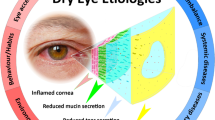Abstract
This review examines the impact of moderate to severe dry eye disease on daily life and medical-resource utilization. The results suggest that current treatment paradigms can lead to unacceptable costs in both quality of life and progressive use of healthcare resources. Evidence linking this disease to T-cell-mediated inflammatory processes lays the foundation for understanding the clinical benefits of topical cyclosporine, an immunomodulatory and anti-inflammatory agent.
Similar content being viewed by others
References
Lemp MA. Report of the National Eye Institute/Industry Workshop on Clinical Trials in Dry Eyes.CLAOJ. 1995;21:221–232.
Lubniewski AJ, Nelson JD. Diagnosis and management of dry eye and ocular surface disorders.Ophthalmol Clin North Am. 1990;3:575–594.
Lemp MA. Recent developments in dry eye management.Ophthalmology. 1987;1299-1304.
Mackie IA, Seal DV. Diagnostic implication of tear protein profiles.Br J Ophthalmol. 1984;68: 321–324.
Seal DV. The effect of aging and disease on tear constituents.Trans Ophthalmol Soc UK. 1985; 104:355–362.
Lemp MA, Mahmood MA, Weiler HH. Association of rosacea and keratoconjunctivitis sicca.Arch Ophthalmol. 1984;102:556–557.
Scott IU, Flynn HW, Feuer W, et al. Endophthalmitis associated with microbial keratitis.Ophthalmology. 1996;103:1864–1870.
Hirsch JD, Kozma CM, Wojcik AR, Reis B. Economic and quality of life impact of dry eye symptoms: a Sjögren’s patient survey.Invest Ophthalmol Vis Sci. 1998;39:S65. Abstract.
Stevenson D, Tauber J, Reis B, the Cyclosporin A Phase 2 Study Group. Efficacy and safety of cyclosporin A ophthalmic emulsion in the treatment of moderate-to-severe dry eye disease: a dose-ranging, randomized trial.Ophthalmology, in press.
Sall K, Stevenson OD, Mundorf TK, Reis B, the CsA Phase 3 Study Group. Two multicenter, randomized studies of the efficacy and safety of cyclosporine ophthalmic emulsion in moderate to severe dry eye disease.Ophthalmology. 2000;107:631–639.
Damato BE, Allan D, Murray SB, Lee WR. Senile atrophy of the human lacrimal gland: the contribution of chronic inflammatory disease.Br J Ophthalmol. 1984;68:674–680.
Pflugfelder SC, Wilhelmus KR, Osato AS, et al. The autoimmune nature of aqueous tear deficiency.J Ophthalmol. 1986;93:1513–1517.
Williamson J, Gibson AAM, Wilson T, Forrester JV, Whaley K, Kick WC. Histology of the lacrimal gland in keratoconjunctivitis sicca.Br J Ophthalmol. 1973;57:852–858.
Stern ME, Beuerman R, Fox RL, Gao J, Mircheff AK, Pflugfelder S. The pathophysiology of dry eye: the interaction between the ocular surface and lacrimal glands.Cornea. 1998;17:584–589.
Kroemer G, Martinez A. Cytokines and autoimmune disease.Clin Immunol Immunopathol. 1991;61:275–295.
Smith JA, Stern ME, Gao J, Schwalb TA, Whitcup SM. Evaluation of the conjunctival cell cycle environment in keratoconjunctivitis sicca (KCS).Invest Ophthalmol Vis Sci. 1999;40:S559. Abstract.
Pepose JS, Akata RF, Pflugfelder SC, Vorgt W. Mononuclear cell phenotypes and immunoglobulin gene rearrangements in lacrimal gland biopsies from patients with Sjögren’s syndrome.Ophthalmology. 1990;97:1599–1605.
Turner K, Pflugfelder SC, Ji Z, Feuer WJ, Stern M, Reis B. Interleukin-6 levels in the conjunctival epithelium of patients with keratoconjunctivitis sicca treated with cyclosporine ophthalmic emulsion.Invest Ophthalmol Vis Sci. 1999;40:S558. Abstract.
Kunert KS, Tisdale AS, Stern ME, Smith JA, Gipson IK. Effect of cyclosporine ophthalmic emulsion on the number of inflammatory cells and goblet cells in conjunctival biopsies of patients with dry eye.Invest Ophthalmol Vis Sci. 1999;40:S771. Abstract.
Nelson JD, Wright JC. Conjunctival goblet cell densities in ocular surface disease.Arch Ophthalmol. 1984;102:1049–1051.
Kaswan RL, Salisbury M-A, Ward DA. Spontaneous canine keratoconjunctivitis sicca. A useful model for human keratoconjunctivitis sicca: treatment with cyclosporine eye drops.Arch Ophthalmol. 1989;1210-1216.
Morgan RV, Abrams KL. Topical administration of cyclosporine for treatment of keratoconjunctivitis sicca in dogs.J Am Vet Med Assoc. 1991;199:1043–1046.
Olivero DK, Davidson MG, English RV, Nasisse MP, Jamieson VE, Gerig TM. Clinical evaluation of 1% cyclosporine for topical treatment of keratoconjunctivitis sicca in dogs.J Am Vet Med Assoc. 1991;199:1039–1042.
Webster DL. A comparative approach to topical cyclosporine therapy.Eye. 1997;11:453–464.
Foulks GN, Pflugfelder SC, Lemp MA, Stern KL, Burk CT, Reis BL. A randomized doublemasked clinical trial to assess efficacy and safety of a 1% CsA-containing ophthalmic ointment vs placebo in patients with keratoconjunctivitis sicca (KCS) associated with Sjögren’s syndrome (SS).Invest Ophthalmol Vis Sci. 1996;37:S646. Abstract.
Helms HA, Rapoza P, Stern KL, Burk CT, Rosenthal A, Reis BL. A randomized double-masked clinical trial to assess the safety and comparative efficacy of three concentrations of a cyclosporinecontaining ophthalmic ointment vs placebo in patients with keratoconjunctivitis sicca (KCS).Invest Ophthalmol Vis Sci. 1996;37:S646. Abstract.
Laibovitz RA, Solch S, Andriano K, et al. Pilot trial of cyclosporine 1% ophthalmic ointment in the treatment of keratoconjunctivitis sicca.Cornea. 1993;124:311–323.
Power WJ, Mullaney P, Farrell M, Collum LM. Effect of topical cyclosporin A on conjunctival T cells in patients with secondary Sjögren’s syndrome.Cornea. 1993;12:507–511.
Calne RY, White PJG. The use of cyclosporin A in clinical organ grafting.Ann Surg. 1982;9:330–335.
Kirby B, Harrison PV. Combination low-dose cyclosporin (Neoral) and hydroxyurea for severe recalcitrant psoriasis.Br J Dermatol. 1999;140:186–187.
Popovic M, Stefanovic D, Pejnovic N, et al. Comparative study of the clinical efficacy of four DMARDs (leflunomide, methotrexate, cyclosporine, and levamisole) in patients with rheumatoid arthritis.Transplant Proc. 1998;30:4135–4136.
Holland EJ, Olsen TW, Ketcham JM, et al. Topical cyclosporin A in the treatment of anterior segment inflammatory disease.Cornea. 1993;12:413–419.
Belin MW, Bouchard CS, Phillips TM. Update on topical cyclosporin A. Background, immunology, and pharmacology.Cornea. 1990;9:184–195.
Gundoz K, Özdemir Ö. Topical cyclosporin treatment of keratoconjunctivitis sicca in secondary Sjögren’s syndrome.Acta Ophthalmol. 1994;72:438–442.
Schiffman RM, Muhich A, Christianson M, et al. The reliability and validity of the Ocular Surface Disability Index (OSDI).Invest Ophthalmol Vis Sci. 1998;39:S65. Abstract.
Evens C, Crawford B. Patient self-reports in pharmacoeconomic studies: their use and impact on study validity.Pharmacoeconomics. 1999;15:241–256.
Author information
Authors and Affiliations
Rights and permissions
About this article
Cite this article
Nelson, J.D., Helms, H., Fiscella, R. et al. A new look at dry eye disease and its treatment. Adv Therapy 17, 84–93 (2000). https://doi.org/10.1007/BF02854841
Issue Date:
DOI: https://doi.org/10.1007/BF02854841




